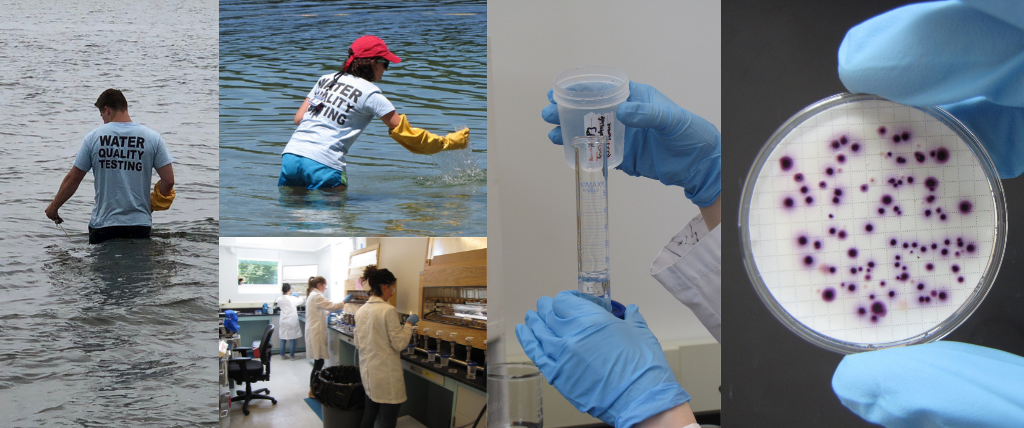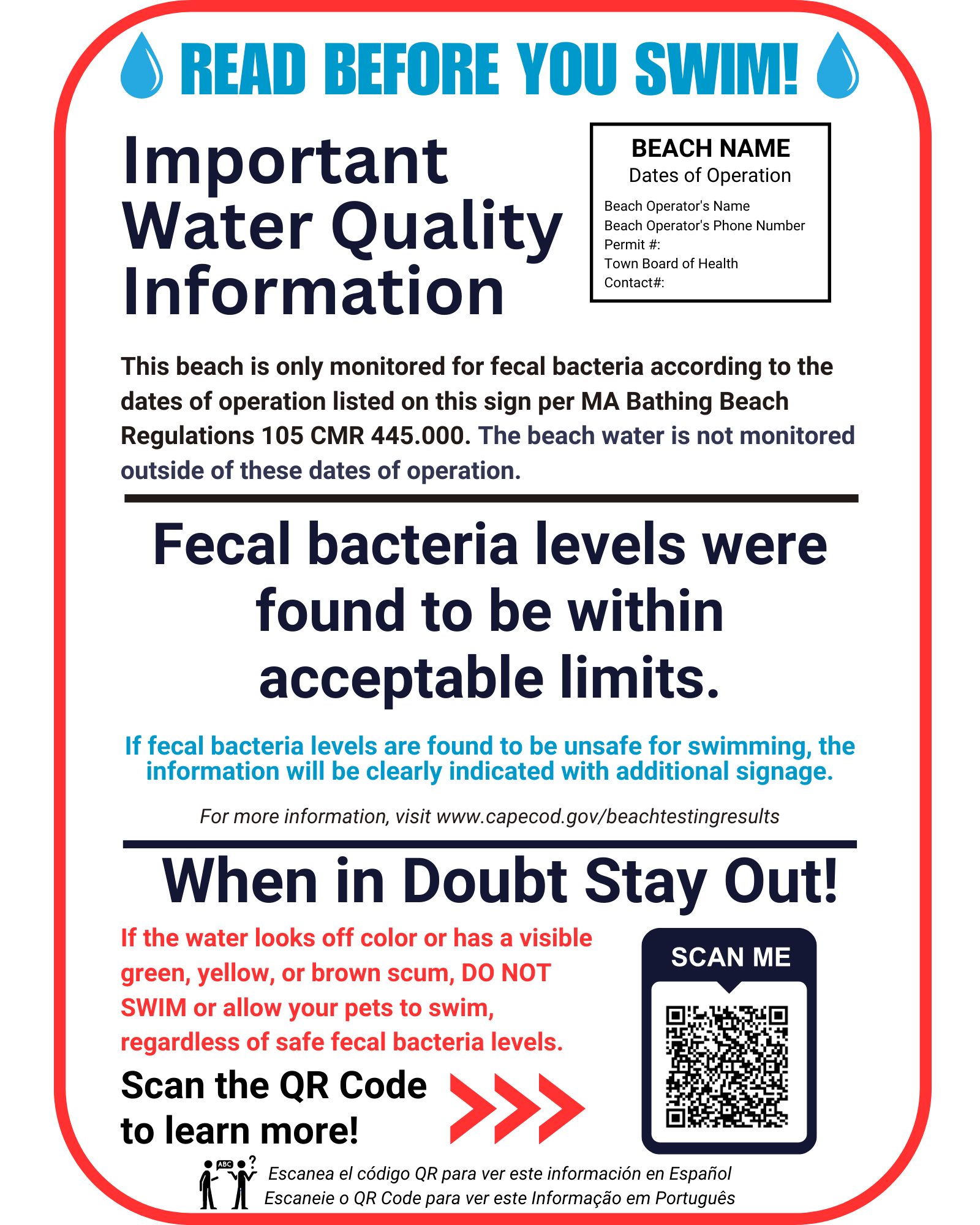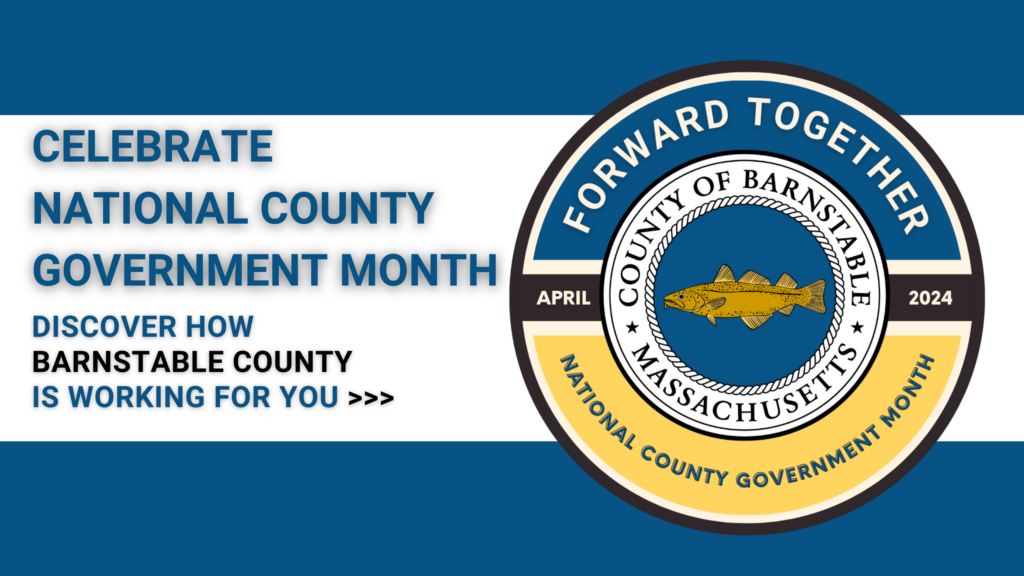
Bathing Beach Water Quality

Barnstable County Beach Monitoring Data
Laboratory Analysis of Fecal Bacteria Indicators, E.coli and Enterococci
About the Beach Monitoring Program
Barnstable County has been monitoring Cape Cod’s beach water quality for over 30 years. In 2002, our efforts were formalized and expanded as the result of amendments to the Clean Water Act that were passed to improve the quality of coastal recreational waters. To date, Barnstable County receives funding from the United States Environmental Protection Agency through the Massachusetts Department of Public Health to conduct sampling and bacteriological analyses of public marine beach water. In addition, the program is offered to semi-public beach operators (residential homeowner’s associations and hotels/motels) for a low per-sample cost.
Over the past 18 years, the beach sampling program has been vital to protecting public health on Cape Cod. We sample and analyze over 350 marine and freshwater beaches weekly, which adds up to over 4,300 samples per season. We test the water for two different types of fecal bacteria; Enterococcus in marine water, and E. coli in fresh water. It is important to note that these two bacteria are considered indicator organisms, which, as their name implies, are used to “indicate” the presence of conditions that have the potential to cause illness. Both organisms are found in the intestines of warm-blooded animals, including humans. Their presence in recreational waters suggests that other harmful organisms and viruses (called pathogens) might be present. If these pathogens are inadvertently ingested while swimming, they may cause a variety of diseases, the most common of which is a mild gastroenteritis with flu-like symptoms. This can be inconvenient and even dangerous, especially for those who are immunocompromised.
You might wonder what causes harmful bacteria to get into the bathing water. Stormwater runoff is a dominant cause for elevated indicator bacteria levels. Runoff carries pollutants from roads and other paved surfaces directly to the surface water of beaches and ponds. Other possible causes of fecal contamination of recreation waters are animal wastes from pets and wild animals. Common waste observed on beaches can be from dogs, geese, ducks, seagulls, seals and fox.
In order to adequately protect beach goers Cape wide and maintain compliance with Massachusetts Bathing Beach Regulations 105 CMR 445.000, Barnstable County utilizes a seasonal staff of four bathing beach sampler/analysts to collect and analyze weekly beach water samples. The samples are delivered to our water quality laboratory and analyzed for the indicator organisms described above. It takes 24 hours to determine if the bacteria are present in a given sample. The maximum allowable number of Enterococci are 104 colony forming units per 100ml of marine water, or 235 colony forming units per 100ml of fresh water. If these standards are exceeded, a sampler is deployed immediately to collect a re-test. Based on recent amendments to the bathing beach regulations, the beach may remain open unless the results of the re-test indicate levels higher than the Massachusetts standards. Some beaches that have a history of consecutive closures over the last four bathing seasons must be closed after only one exceedence.
When a beach sample re-test exceeds the limit for bacteria in bathing water, our program notifies the health agent in the town where the beach is located and they have 24 hours to ensure that the beach is closed to swimming. When the second re-test results show acceptable bacteria levels, the beach may be re-opened to swimming. Please remember that a beach posted closed to swimming does not mean you cannot still enjoy walking on the beach, collecting seashells, building sand castles and playing sports.
For more information regarding our program, our testing methodologies, closure policies and more, please refer to our frequently asked questions below.
Frequently Asked Questions
Simply put, to protect public health. The beach water samples are analyzed for “indicator” organisms, which are not harmful themselves, but indicate the potential for the presence of human pathogens. A human pathogen is an organism or virus that is capable of producing an illness in a human host.
Indicator organisms, as their name implies, are used to “indicate” the presence of conditions which have the potential to cause illness. Through various studies conducted by Environmental Protection Agency (USEPA) and others, it has been determined that certain levels of some indicator organisms in bathing beach waters represent a threat to public health. The indicator organisms we test for are called Enterococcus and E. coli. Enterococcus has proven the most useful bacterial indicator for determining the extent of fecal contamination in marine recreational waters, while E. coli has proven most useful in freshwater situations.
An important thing to remember regarding indicator organisms is that, by themselves, they may not be harmful. Rather, since these organisms are found in the intestine of many warm-blooded animals, their presence suggests that other harmful organisms and viruses also in the intestine of warm-blooded animals (including humans) may be present. If these harmful organisms and viruses (called pathogens) are present and are inadvertently ingested while swimming, they may cause a variety of diseases. The good news is that the most common illness is a mild gastroenteritis with flu-like symptomology. But even the milder diseases can be problematic to immune-compromised people.
Stormwater runoff is the dominant cause for elevated indicator bacteria levels. Runoff carries pollutants from roads and other paved surfaces directly to the surface water of beaches and ponds. Other possible causes are animal waste from pets as well as wild animals. Common waste observed on beaches can be from dogs, fox, seals, seagulls, ducks and geese. Most warm-blooded animals carry the same indicator bacterium used to classify recreational waters.
Sanitary wastes from marine craft have been increasingly eliminated as a potential threat to our bathing beaches for two reasons. Foremost, many marinas now have pump-out facilities for their visitors (often at no cost), and second, if a boat does discharge sanitary waste, it is required that it do so at least 3 miles offshore, where dilution rates are very high.
When a sample is taken at one of Cape Cod’s beaches, the water is brought back to the laboratory and tested for the presence of the indicator organism Enterococci (if the sample is salt/marine water) or E. coli (if the sample is fresh water). It takes 24 hours to determine if Enterococci or E. coli are present in the sample. The maximum allowable number of Enterococci colony forming units per 100ml sample are 104. The maximum allowable number of E. coli colony forming units per 100ml sample are 235. If a sample exceeds the limit for Enterococci or E. coli, we say that the beach “failed” or that an “exceedence” has occurred, and our samplers are sent to retrieve a re-sample. If, after 24 hours, it is determined that the results of the re-sample are higher than the maximum allowable number of colony forming units described above, the health agent in the town where the beach is located is notified and the beach must be closed to swimming within 24 hours.
In some cases, if a beach has experienced more than two consecutive exceedences (both the initial sample and re-sample exceeded the limits for bacteria in bathing water) within the last four bathing seasons, that beach is placed on a list of beaches that must be posted closed to swimming after only one exceedence. In other words, due to historical data showing that a beach is known to have consecutive exceedences, we don’t wait for the results of the re-sample; we notify the health agent that the beach must be closed within 24 hours (you can read a more detailed explanation for this below).
Running averages (geometric means) are kept at all bathing beach sites as well. The geometric mean is calculated using the most recent 5 non-storm event samples in the bathing season. For marine beaches the geometric mean must not exceed 35 Enterococci CFU/100 ml., and for fresh water ponds the geometric mean must not exceed 126 E. coli CFU/100 ml.
In the spring of 2014, just prior to the start of the bathing season, the Massachusetts Bathing Beach Regulations 105 CMR 445.000 were amended to stipulate that a beach must be closed to swimming after not just one, but TWO consecutive exceedences of the standard for bacteria in bathing water. The rationale behind this change was as follows: when a sample was taken at any given location, it would take 24 hours to obtain a result (due to the required incubation period of the bacteria). According to the old rule, if, after the 24 hour incubation period, the result showed an exceedance of the allowable limit for bacteria, the beach would be posted closed to swimming and a re-test would then be taken by our samplers as soon as possible (the results of which would determine whether or not the beach could be re-opened). Officials pondered whether any contamination present during the initial sampling event would still be present by the time the re-sample was collected, and whether it would be prudent to close the beach after only one exceedence if historically, re-sampling always showed favorable results.
The Massachusetts Department of Public Health did an exhaustive analysis of the past 13 years of beach sampling data, and determined that in the vast majority of cases, the re-test results were coming back well within the allowable limits. Again, this suggested that by the time those re-samples were taken, the bacteria counts had likely returned to an acceptable level after a brief or “transient” contamination event. They then concluded that it would make more sense to close a beach only if the re-sample showed a bacterial exceedence, indicating a less transient contamination event. There are some exceptions to this rule, however. Those water bodies that experienced more than two consecutive exceedences over the past four bathing seasons were placed on a special list of beaches that must be posted closed to swimming after only one exceedence, due to a history of longer contamination events.
In the event that a sample is found to have a bacteria level higher than the acceptable limit, a re-sample of the bathing water will be conducted as soon as possible. As described above, in most cases, the results of the re-sample dictate whether or not a beach is closed. Massachusetts Bathing Beach Regulations 105 CMR 445.000 stipulate that a beach must be posted closed to swimming after two consecutive exceedences. Therefore, if the initial sample and the resulting re-sample are found to exceed the limit for Enterococcus in marine water or E. coli in freshwater, the beach must be posted closed within 24 hours of the time our laboratory notifies the town health agent of that exceedence. The beach will then be re-tested daily by our samplers until test results show acceptable bacteria levels. In many cases, the beach is re-opened after the tides and currents in open waters act to disperse contaminants. Unfortunately, however, the laboratory analysis of a sample does not provide instantaneous results. There is a 24-hour incubation period for all samples. Therefore it is common for a bathing water closure to last for a day or two following a second exceedence to ensure public health and safety.
Many safe activities can be enjoyed while the beach is closed to bathing and swimming. Examples include: walking on the beach, collecting seashells, building sand castles, and playing sport activities such as volleyball, paddleball, Frisbee, football, etc.
– Do not feed the birds.
– Do not walk on the dunes: vegetation is a valuable filter of pollutants, and prevents erosion and reduces runoff.
– Clean up after your pets.
– Do not bury diapers or trash into the sand.
OTHER RESOURCES
Massachusetts Department of Public Health Environmental Toxicology Program
State Beach Website – Marine beach closure data for the state of Massachusetts.
EPA’s Beach Monitoring and Notification Website – Learn more about beach monitoring policy and legislation at the federal level.
Natural Resources Defense Council (NRDC) – NRDC pressures the federal government to protect all U.S. waters under the Clean Water Act.
Woods Hole Oceanographic Institution – Learn more about beach sampling and why the beaches are sometimes closed due to elevated bacteria levels.




